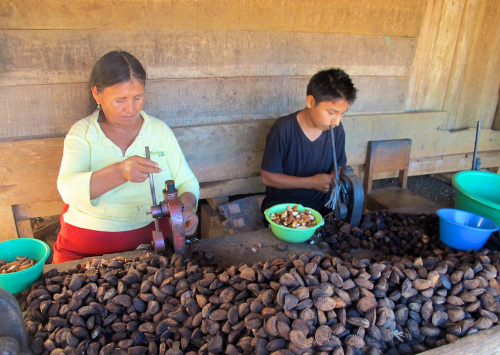PUERTO MALDONADO, Peru (13 November, 2012)_Field researchers working in remote, hard-to-reach areas have greater challenges than just navigating treacherous back-country roads and trying to protect the data collected from the harsh elements.
Even if scientific research is focused on changes local livelihoods and perceptions of local people, researchers need to keep “the bigger picture in mind” — such as complicated governance structures and unpredictable market forces — to be able to interpret their findings, said forestry experts after spending four months in Peruvian Amazon.
Such lessons were learnt when seven young, graduate-level census takers, employed by the Center for International Forestry Research, interviewed Brazil nut harvesters taking part in a project that aims to slow climate change by reducing deforestation and forest degradation (REDD+).
Though still in its early stages, those gathering the nuts from the 40-foot-high trees will eventually be granted a new nut processing factory, as part of the REDD+ project, to help them glean higher incomes from their product.
The rationale is that if they continue to benefit from the forest, they may be more likely to protect it.
Valerie Garrish, the field supervisor in CIFOR’s Global Comparative Study on REDD+ in Peru, said when her team first arrived in the Puerto Maldonado, the capital of Madre de Dios and the starting point for popular tourist trips into the Amazon, they were met by skepticism.
The harvesters were initially hesitant to answer questions about who owned their land, how it was being used and if they were satisfied with their lives.
“Why is this research being conducted?” they asked.
We found – not surprisingly – that the main hope of most people was that local REDD+ projects would improve their incomes…their main worry was that it would negatively affect their livelihoods.
It was only after researchers patiently explained the broader research goals _ figuring out if the REDD+ project could indeed help improve lives while promoting forest conservation — that barriers were broken and the 250 or so participants started to open up.
It’s a simple matter of trust, Garrish said, adding that researchers also assured participants they would return to the community to share their findings.
The market influence
It was equally important, and difficult, to understand how market forces affect the lives of those being interviewed, Garrish said.
The researchers quickly learned that the nut harvesters’ well-being was directly linked to the forest, but that the amount of money they were able to fetch for the nuts on the market swung wildly, often within the same year.
For instance, in January 2012, when the GCS-REDD field data was collected, nuts fetched four times as much as they were able to get later the season.
Researchers, who will return to the community in early 2014 to see if the REDD+ project has improved the harvesters’ lives, must be contentious of the fact that these kinds of fluctuations will inevitably skew the research results if not properly controlled.
As noted by Amy Duchelle, CIFOR’s field coordinator for the Global Comparative Study on REDD+ in Latin America, if Brazil nut prices happen to be high when the team comes back, it could make the project look like a success. On the contrary, if nut prices are low at the time of sampling, the project could be viewed as a flop.
Different countries, different expectations
Peru is not the only place where research on incipient REDD+ projects is being carried out. CIFOR researchers have also been dispatched to Brazil, Cameroon, Tanzania, Indonesia and Vietnam to try to figure out what makes REDD+ projects most cost-effective and equitable.
The results will be presented to policy makers and REDD+ project implementers so that they can see what adjustments should be made in policy and practice for the next generation of projects to be more successful.
One thing that’s certain, Duchelle said, is that the hopes and worries of communities are somewhat similar from one country to the next.
“We found – not surprisingly – that the main hope of most people across all sites in Brazil, Cameroon, Tanzania, Indonesia and Vietnam was that the local REDD+ project would improve their incomes and their main worry was that it would negatively affect their livelihoods.”
While the data from Peru still needs to be incorporated into the global analysis on local perceptions of REDD+, preliminary results show that Peruvian harvesters were concerned, among other things, that the nut forests are not well protected, that they might lose either the concessions to extract the nuts or be limited in their rights, that they will not get the right compensation for the carbon storage in these forests, and even that the project will not become a reality.
The governance aspect
Governance is also a key factor to consider in implementation, Duchelle said, noting there is less of a subnational governance structure for REDD in Peru than, for instance, Brazil.
“The regional governments in Peru, although they have quite a lot of power, initially assumed less of a leadership role in REDD+. It seemed that Peruvian REDD+ projects were popping up all over the place without a move towards cohesive jurisdictional frameworks,” she said.
“But this seems to be changing with clear advancement on the establishment of regional reference levels and the regional government of Madre de Dios’ recent affiliation with the Governors Climate and Forests (GCF) Task Force.”
This work forms part of CIFOR’s Global Comparative Study on REDD+, which is supported by the Norwegian Agency for Development Cooperation (NORAD) and AusAid.
We want you to share Forests News content, which is licensed under Creative Commons Attribution-NonCommercial-ShareAlike 4.0 International (CC BY-NC-SA 4.0). This means you are free to redistribute our material for non-commercial purposes. All we ask is that you give Forests News appropriate credit and link to the original Forests News content, indicate if changes were made, and distribute your contributions under the same Creative Commons license. You must notify Forests News if you repost, reprint or reuse our materials by contacting forestsnews@cifor-icraf.org.
